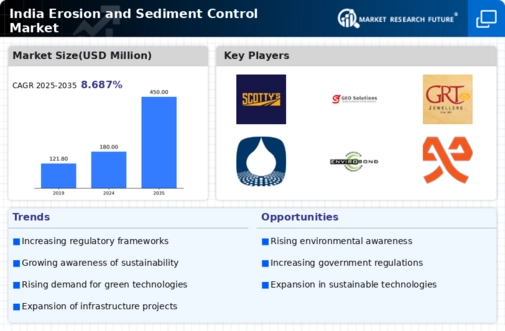Climate Change and Extreme Weather Events
The impact of climate change is becoming increasingly evident in India, with rising temperatures and erratic rainfall patterns leading to more frequent and severe weather events. These changes exacerbate soil erosion and sedimentation issues, particularly in vulnerable regions. The erosion and-sediment-control market is likely to experience heightened demand for adaptive solutions that can withstand extreme weather conditions. For instance, the implementation of bioengineering techniques and the use of geotextiles are becoming more prevalent as they offer resilience against heavy rainfall and flooding. The urgency to address these challenges suggests that stakeholders in the erosion and-sediment-control market must innovate and adapt their strategies to meet the evolving environmental landscape.
Government Initiatives and Funding Programs
The Indian government has recognized the critical need for effective erosion and sediment control, leading to the introduction of various initiatives and funding programs. Schemes such as the Pradhan Mantri Krishi Sinchai Yojana aim to enhance irrigation efficiency while minimizing soil erosion. Additionally, the National Mission for Sustainable Agriculture emphasizes the importance of soil health management. These government efforts are likely to stimulate growth in the erosion and-sediment-control market by providing financial support and resources for implementing best practices. As public awareness of soil conservation increases, the market may see a rise in demand for products and services that align with these initiatives, fostering a more sustainable approach to land management.
Agricultural Practices and Soil Conservation
Agriculture remains a cornerstone of India's economy, contributing approximately 17% to the GDP. However, traditional farming practices often lead to soil degradation and erosion. The erosion and-sediment-control market is increasingly influenced by the need for sustainable agricultural practices that conserve soil health. Initiatives promoting contour farming, cover cropping, and agroforestry are gaining traction, as they help reduce soil erosion while enhancing productivity. The government has also introduced various schemes to support farmers in adopting these practices, which could potentially increase the market for erosion control products. As awareness grows, the demand for innovative solutions in the erosion and-sediment-control market is expected to rise, reflecting a shift towards more sustainable agricultural methods.
Increased Urbanization and Infrastructure Development
The rapid urbanization in India is a primary driver for the erosion and-sediment-control market. As cities expand, the demand for infrastructure projects such as roads, bridges, and buildings increases. These developments often disturb the natural landscape, leading to soil erosion and sedimentation in nearby water bodies. According to recent estimates, urban areas in India are expected to grow by 600 million people by 2031, intensifying the need for effective erosion control measures. The erosion and-sediment-control market is likely to see a surge in demand for solutions that mitigate the impact of construction activities on soil stability and water quality. This trend indicates a growing recognition of the need for sustainable practices in urban planning and development.
Technological Innovations in Erosion Control Solutions
Technological advancements are playing a pivotal role in shaping the erosion and-sediment-control market. Innovations such as drone technology for monitoring erosion-prone areas and the development of biodegradable erosion control mats are gaining traction. These technologies not only enhance the effectiveness of erosion control measures but also reduce environmental impact. The market is witnessing a shift towards smart solutions that integrate data analytics and remote sensing to provide real-time monitoring and assessment of erosion risks. As these technologies become more accessible, they are likely to attract investment and interest from various sectors, including construction, agriculture, and environmental management, thereby driving growth in the erosion and-sediment-control market.


















Leave a Comment